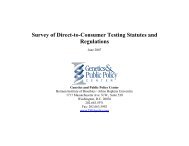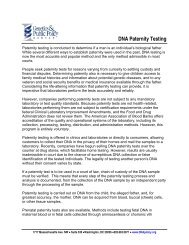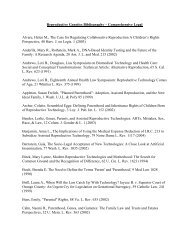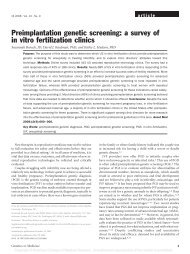Preimplantation Genetic Diagnosis - Genetics & Public Policy Center
Preimplantation Genetic Diagnosis - Genetics & Public Policy Center
Preimplantation Genetic Diagnosis - Genetics & Public Policy Center
Create successful ePaper yourself
Turn your PDF publications into a flip-book with our unique Google optimized e-Paper software.
SAFETY, ACCURACY, EFFECTIVENESS OF PGD<br />
Federal Oversight<br />
Option: FDA Oversight<br />
FDA could issue regulations requiring that, before PGD is<br />
offered to prospective parents, there must be evidence that<br />
both the genetic tests and the manipulation of reproductive<br />
tissue are safe and effective (premarket approval). As with<br />
other FDA regulated products, those seeking to offer PGD<br />
would be required to conduct controlled clinical trials and<br />
submit data from those trials to FDA. Pending FDA review of<br />
that data and agency approval of the tests and procedures,<br />
PGD could be provided only in the context of a research<br />
protocol.<br />
Arguments for:<br />
• Premarket approval would mean that there would be a<br />
much higher level of scrutiny of PGD. If FDA approved a<br />
test or procedure, the public could have a much greater<br />
level of confidence in its safety and effectiveness. In<br />
addition, FDA could require post-market reporting by those<br />
using the FDA-approved tests and procedures, leading to<br />
more information about their safety and effectiveness.<br />
Arguments against:<br />
• FDA’s involvement, particularly if premarket approval were<br />
required, would have the effect of significantly limiting<br />
access to PGD. Prospective parents would be able to use<br />
unapproved procedures only as part of a research study.<br />
Providers might choose to leave the field rather than<br />
comply with FDA requirements.<br />
• It is not clear that FDA has the authority to regulate PGD<br />
or the IVF procedures required to perform it. FDA’s<br />
governing statutes don’t directly address PGD at all. Any<br />
extension of agency oversight in this area would require<br />
interpreting existing statues as applicable to PGD.<br />
• Given the charged political atmosphere surrounding what<br />
should and should not be done with preimplantation human<br />
embryos, it is not clear that FDA would want to get<br />
involved in this arena even if it has the authority. Without a<br />
specific directive from the Department of Health and<br />
Human Services or a new legislative mandate from<br />
Congress, the agency may be reluctant to get involved.<br />
Does FDA Have the Authority to Regulate<br />
IVF and PGD?<br />
Without new authority from Congress, it could be<br />
difficult for FDA to assert jurisdiction over IVF and<br />
PGD. The agency’s only option might be to argue that<br />
an embryo created by IVF meets its existing definition<br />
of a biological “product” and a laboratory test used to<br />
test the embryo’s DNA constitutes a “medical device,”<br />
since it will be used to treat or prevent a medical<br />
condition (e.g., infertility, genetic disease). Some are<br />
skeptical that FDA could lawfully extend existing<br />
authority to cover PGD and others are simply offended<br />
by the notion of calling an embryo a “product.”<br />
State Oversight<br />
States could use their agencies and authority to play a role in<br />
monitoring and improving the safety and accuracy of PGD.<br />
Option: Involve public health agencies<br />
The activities, authority and responsibilities of state public<br />
health agencies vary from state to state, but in general all<br />
endeavor to influence public health policy and practice. They<br />
promote health by tracking and monitoring disease, promoting<br />
disease prevention, screening newborns, regulating<br />
laboratories, licensing physicians and delivering basic health<br />
services.<br />
It is difficult to create a uniform policy approach for state<br />
public health agencies because, statutorily and bureaucratically,<br />
they take so many different forms. Nonetheless, each agency<br />
could take its basic charge to protect the public health and<br />
apply it to improving the safety and accuracy of PGD. For<br />
example, New York State is developing standards for<br />
laboratories doing genetic testing for PGD.<br />
States could also consider implementing the <strong>Center</strong>s for<br />
Disease Control and Prevention’s (CDC) Model Embryo<br />
Laboratories Certification Program. This certification program<br />
was developed by the CDC with public input and provides<br />
specific standards for laboratories that handle human<br />
embryos. States could adopt it as a first step toward expanding<br />
their oversight of PGD services.<br />
Arguments for:<br />
• State initiatives may be more politically feasible when a<br />
national approach proves too difficult.<br />
• A state-by-state approach allows additional flexibility<br />
depending on the needs and resources of the state.<br />
• State approaches are often testing grounds for systems that<br />
may later be adopted nationally.<br />
Arguments against:<br />
• A state-by-state approach means that safety, accuracy and<br />
effectiveness may vary depending solely on where the<br />
patient lives.<br />
• State public health agencies already are stretched thin and<br />
would be hard pressed to find additional resources and<br />
develop new expertise to address new fields.<br />
20<br />
VISIT WWW.DNAPOLICY.ORG TO COMMENT










